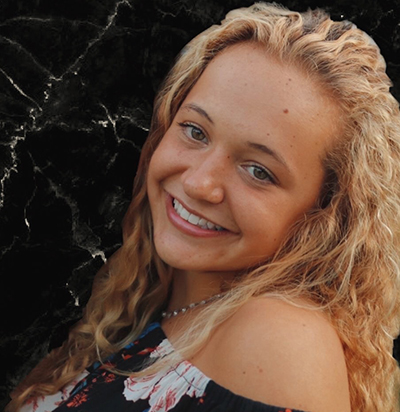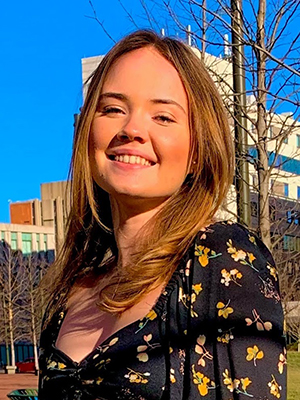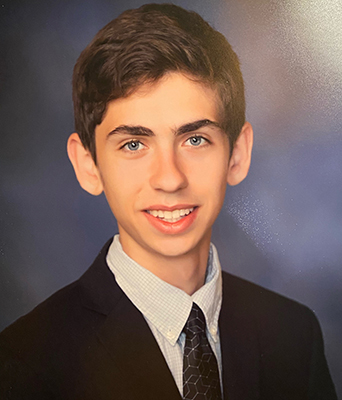Students Receive Chemistry Research Experience Through Maryanoff Scholars Program
November 18, 2021
Thanks to the generous support of two Drexel alumni, selected College of Arts and Sciences students are able to participate in a chemistry research program during the first summer after their freshman year.
Bruce and Cynthia Maryanoff met while Bruce was a PhD student and Cynthia was an undergraduate, both working under the late Robert Hutchins, PhD, a Drexel professor and department head of chemistry. Hutchins’ mentorship would inspire the Maryanoffs to give back to Drexel to provide other undergraduate students the opportunity to conduct research to further achieve their educational and career goals.
Students selected for the Maryanoff Scholars program receive a stipend and Drexel housing for 8-10 weeks over the summer while they conduct research under the supervision of a chemistry faculty member of their choosing.
The program concludes with a symposium that takes place in the fall. Each Maryanoff Scholar gives a 10-minute presentation on their research project to the Maryanoffs. Due to the coronavirus pandemic, the symposium was unable to take place in Fall 2020, so this year’s gathering included Maryanoff Scholars from both 2020 and 2021.
Below is a selection of the 2020 and 2021 Maryanoff Scholars who shared their research and experience in the program.
Asad Baig

Mentor: Ezra Wood, PhD
Research: In a time of airborne illnesses such as COVID-19, adequate ventilation becomes of paramount importance to prevent the spread of pathogens. Ventilation rates of classrooms, auditoriums and other public spaces at Drexel were measured using the sublimation of dry ice. The data was then compiled and analyzed. The analyzed data was sent to Drexel Environmental Health and Safety to help inform and lead maintenance in improving ventilation throughout the University. For instance, in the Drexel main auditorium, several air filters were set up to increase the air purification.
On being a Maryanoff Scholar: My favorite part of being a Maryanoff Scholar was interacting with my mentor, Dr. Ezra Wood. Dr. Wood was very helpful in leading the project and teaching me techniques which were helpful in conducting research under him. Additionally, he gave me a kind and generous introduction to the world of academic research which has sparked my interest in conducting further research as an undergraduate.
Lee Feinman

Mentor: Ezra Wood, PhD. I also worked with student Alexa Rhoads and PhD student Andrew Lindsay.
Research: The research I contributed to was centered around quantification of peroxy radicals. Peroxy radicals play a central role in the formation of ground-level ozone, otherwise considered smog. Our experiments attempted to characterize previously established analytical methods at low pressure to improve the consistency of the instrument over relative humidity levels ranging from 0 - 70%.
On being a Maryanoff Scholar: I grew an immense appreciation for science and its process. What it means to be a researcher and a published chemist all were given new meanings to me. I learned that for as much diligent work that needs to be put in, the same curiosity and creativity in solving problems that drew me to chemistry truly still exists. This recognition was my favorite part of the program.
Riti Jupudi

Mentor: Dionicio Martinez, PhD, Synthetic Organic Chemistry Lab
Research: The Safe Utilization of Ex-Situ Generated Carbon Monoxide in the Catalytic Pauson-Khand Reaction
The Pauson-Khand reaction (PKR) has been used over the years to synthesize cyclopentenones, important building blocks for pharmaceuticals and other complex molecules. The PKR is a [2+2+1] cycloaddition that involves a reaction between an alkene, alkyne and carbon monoxide (CO). Its catalytic form requires the use of a constant external source of carbon monoxide to promote the completion of the reaction. The previous method was high-risk; it involved filling up a balloon with CO gas and inserting it into the reaction flask. There are many points of exposure to CO poisoning with this method, making it a dangerous option for running the PKR. The research conducted as a Maryanoff Scholar was to determine how to utilize Carbon-Monoxide Releasing Molecules (CORMs) to generate CO gas in a closed system. This involved the use of a flask that contained two wells connected by a bridge, known as an H-flask, to conduct the PKR and the CO gas generation reaction simultaneously. This is a completely closed system, helping prevent the risk of CO poisoning. This research was primarily conducted to determine a safer method of utilizing CO when synthesizing cyclopentenones. The products formed using the traditional catalytic PKR and the new method were the same, and their yields were comparable. The new method proved to be a safer method that does not compromise the chemistry of the Pauson-Khand Reaction.
On being a Maryanoff Scholar: My favorite part of being a Maryanoff Scholar was being able to go into the lab and apply the techniques I learned in the classroom to new ideas and research. I was a Maryanoff Scholar during a time of remote learning, so I did not get to step foot in a lab for months before this opportunity. Gaining the chance to understand the real-world applications of the reactions and mechanisms I was learning in my lectures was extremely beneficial. Dr. Martinez’s group also gave me a lot of freedom and guidance that helped me determine what it takes to be an effective researcher.
Callie Stitt

Mentor: Hai-Feng Ji, PhD. I worked directly with Matthew Mieles, a graduate student in the Chemistry department, and alongside Sky Harper, a STAR Scholar.
Research: Chemical modification of wood increases its performance properties by covalently bonding chemicals into wood cell walls. Polyethylene glycol diacrylate (PEGDA) treatment is an effective approach to increase the strength of spruce wood for various applications. In this study, PEGDA was impregnated into wood samples, then polymerized by dielectric barrier discharge (DBD) plasma to form wood polymer composites (WPC). The strength of the wood samples was characterized by three-point flexure testing. PEGDA-treated wood resulted in an increased strength than untreated wood. PEGDA polymerized by the UV-polymerization method proved to be weaker than wood polymerized by DBD plasma.
On being a Maryanoff Scholar: I would say my favorite part of being a Maryanoff Scholar was all that I learned. Not only about organic chemistry and the research that encompasses it, but also what I learned about myself. What first seemed very daunting, I came to a place where I was able to solve issues that occurred in my research and recognize what went wrong. I learned that I can do things that I once thought I would never be able to. I was able to learn how to read sophisticated scientific writings and interpret what they were saying, which was at first very difficult. I am so grateful for the opportunity to be a Maryanoff Scholar and for all that I gained from this experience.
Jessica Waite

Mentor: Hai-Feng Ji, PhD, and graduate student mentor Greg Schwenk
Research: While in lockdown, I focused on writing and publishing a paper with my mentor, Dr. Haifeng Ji, on the improved photocatalytic applications of transitional metal oxides due to the introduction of nanopillars and micropillars. The main mechanisms explored included increasing surface area of the material in order to increase the number of active sites taking part in reactions at a material’s surface. Introducing other materials into a sample of transitional metal oxide helps narrow the band gap of the material so that it may be observed within the Ultraviolet-Visible light range. Wet lab work included the replication of a rapid cellulose dissolution lab where fibrous cellulose was made to dissolve in a precooled solution of lithium hydroxide and urea, which, at low temperatures, contributed to the dispersity of the cellulose.
On being a Maryanoff Scholar: My favorite aspect of the Maryanoff Program was the opportunity for networking within the department. I was able to speak to many different professors and graduate students who helped share different perspectives and approaches to their work. I am also incredibly thankful for the opportunity to be present in a chemistry lab during the pandemic lockdown. Many students struggled with online lab, whereas I believe having access to the lab during the pandemic significantly aided my studies and lab etiquette.
John Walters

Mentor: Hai-Feng Ji, PhD. I also worked closely with Gregory Schwenk, a graduate student in the Ji group.
Research: Since the discovery of phosphorene, phosphorus-based semiconducting nanomaterials have garnered significant interest; however, these materials often come with the significant trade off of degrading in the presence of water. The previously reported materials Cu2P3I2 and Ag2P3I2 are air stable phosphorus-based semiconducting nanomaterials. We assessed the ability of these materials to act as humidity sensors, and it was found that the conductivity of these devices varies in orders of magnitude in the presence of varying humidity, making them viable sensors. Along with these humidity studies, tests were run to better explain the mechanism of conduction for these materials. We assessed the possibility of both ionic and electronic conduction in these materials, which were previously thought to only display ionic conductivity. Furthermore, chemical vapor deposition and ion-exchange reactions were utilized to synthesize novel metal phosphorus halide materials, which were subsequently characterized and compared with Cu2P3I2 and Ag2P3I2.
On being a Maryanoff Scholar: I enjoyed participating in research in which I am interested. Because this was my first research experience, this was the first time I helped contribute new knowledge in a field in which I am interested. I have been continuing my research from the summer out of interest in this project.
About the Maryanoffs

Bruce Maryanoff, PhD, completed a bachelor of science in chemistry in 1969 and a doctorate in organic chemistry in 1972. After graduating, he joined McNeil Laboratories, Inc. (a Johnson & Johnson subsidiary) in 1974 and advanced on the scientific ladder in various J&J pharmaceutical units to the highest scientific position in the company. He was active in the medicinal and organic chemistry and, while at J&J, one of his many discoveries was Topiramate, a unique sugar sulfamate drug that has been marketed worldwide for the treatment of epilepsy and migraine attaining annual sales of more than $2 billion. He retired from J&J in 2010, and is still currently affiliated with many institutes.
Cynthia “Cyndie” Maryanoff, PhD, graduated from Drexel in 1972 with a bachelor of science in chemistry. She received her PhD from Princeton University. She joined Smith, Kline & French Laboratories in 1977 and moved to McNeil Pharmaceutical in 1981. She retired from J&J in 2013 and has been a professor of experimental therapeutics and medicinal chemistry at the Blumberg Institute and professor of drug delivery at the Pennsylvania Drug Discovery Institute and still remains active in organic chemistry and materials science. She was the first woman to be chair of the Division of Organic Chemistry in 1997 and has had many positions in the American Chemical Society since 1988 to present.
The Maryanoffs have also founded Absolute Palate, LLC, a coffee company specializing in single-estate 100% Kona coffee, with two coffee farms located in Hawaii.